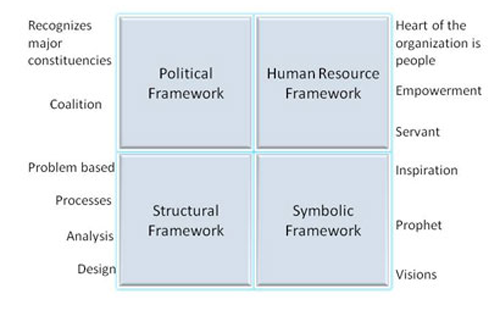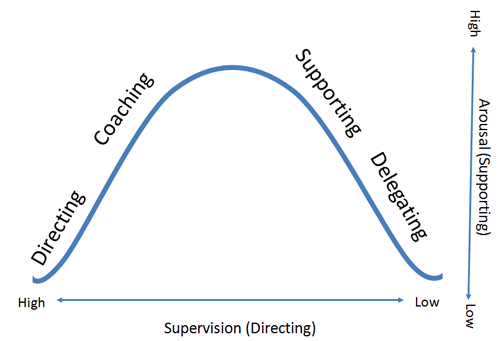Note: This site is moving to KnowledgeJump.com. Please reset your bookmark.
Leadership Models
Leadership models may be defined as guides that suggest specific leadership behaviors to use in a specific environment or situation. In addition, they often use a graphic representation to show the required leadership behavior.

Three models are discussed:
- Managerial Grid - focuses on a leader's concern for task and concern for people to predict leadership outcomes
- Four Framework Approach - uses four common concepts to guide leadership behavior in specific situations
- Situational Leadership - guides a leader on the type of coaching required to develop a worker in a specific situation
Leadership or Managerial Grid
Two large studies found that two types of leader behaviors were important concepts in leadership skills. While the two separate studies used different terms, they can be thought of as concern for people and concern for tasks. The study at Ohio State University identified these two behaviors as (Fleishman, 1953, Stogdill, 1974):
- Consideration - relationship behaviors, such as respect and trust (concern for people)
- Initiating Structure - task behaviors, such as organizing, scheduling, and seeing that work is completed (concern for tasks)
The study at the University of Michigan identified these two behaviors as (Katz,, Maccoby, Morse, 1950; Northouse, 2007):
- Employee Orientation - approaching employees with a strong human relations orientation (concern for people)
- Production Orientation - stressing the technical and production aspect of the job (concern for tasks)
The researchers from Michigan State thought of these two behaviors as being on opposite ends of a single continuum. Thus, a leader could be strong with one of these two behaviors, but would be weaker in the opposite one.
The Ohio State studies viewed these two behaviors as distinct and independent. Thus, a leader could be high or low in one or both behaviors. For example, in the U.S. Army, one of the most important rules is to take care of your soldiers and complete the mission (task) — a leader should be good with both. Bad leaders can do neither or do one, but not the other.
The notion that just two dimensions can describe leadership behavior has the attraction of simplicity. However, humans are far from being two dimensional in their behaviors, hence, you have to learn more than the model, but the model is a great place to start.
Two researchers, Robert Blake and Jane Mouton, (1985) created a short questionnaire that asked leaders how they approached tasks and people. They also created a grid similar to the one shown below. Depending on how a leader scored, would place him or her in one of four quadrants:

The four quadrants represent the level of strength of the two behaviors:
- Authoritarian — strong on tasks, weak on people skills
- Country Club — strong on people skills, weak on tasks
- Impoverished — weak on tasks, weak on people skills
- Team Leader — strong on tasks, strong on people skills
The goal to good leadership is to score at least a 6 on both task and people, which places the leader in the Team Leader grid.
The four leadership behaviors are discussed in more detail below.
Team Leader (high task, high relationship) - These leaders lead by positive example and endeavor to foster a team environment so that all team members can reach their highest potential, both as individual team members and as a group of people who use cooperation and collaboration. They encourage the team to reach goals as effectively as possible, while also working tirelessly to strengthen the bonds among the various members. They normally lead some of the most productive teams.
Authoritarian Leader (high task, low relationship) - Leaders who get this rating are very much task oriented and are hard on their workers (autocratic). There is little or no allowance for cooperation or collaboration. Authoritarian leaders mostly display these characteristics: they are very strong on schedules; they expect people to do what they are told without question or debate; when something goes wrong they tend to focus on who is to blame rather than concentrate on exactly what went wrong and how to prevent it; they are intolerant of what they see as dissent (it may just be someone's creativity), thus it is difficult for their subordinates to contribute or develop.
Country Club Leader (low task, high relationship) - These leaders predominantly use reward power to maintain discipline and to encourage the team to accomplish its goals. Conversely, they are almost incapable of employing the more punitive coercive and legitimate powers. This inability results from fear that using such powers could jeopardize relationships with the other team members.
Impoverished Leader (low task, low relationship) - These leaders use a “delegate and disappear” management style. Since they are not committed to either task accomplishment or maintenance, they essentially allow their team to do whatever they wish and prefer to detach themselves from the team process by allowing the team to suffer from a series of power struggles within the group.
The Sweet Spot on the Grid
Lead Primarily as Team Leader, but be Situational for the Other Three — The most desirable place for a leader to be along the two axes at most times would be a 9 on task and a 9 on people — the Team Leader. However, do not entirely dismiss the other three. Certain situations might call for one of the other three to be used at times. For example, by playing the Impoverished Leader, you allow your team to gain self-reliance. Be an Authoritarian Leader to instill a sense of discipline in an unmotivated worker. Be an Impoverished Leader to allow others to teach others to lead. By carefully studying the situation and the forces affecting it, you will know at what points along the axes you need to be in order to achieve the desired result.
Four Framework Approach
In the Four Framework Approach, Bolman and Deal (1991) suggest that leaders display leadership behaviors in one of four types of frameworks: Structural, Human Resource, Political, or Symbolic:

This model suggests that leaders operate in one of these four categories and there are times when one approach is more appropriate and times when it would not be. That is, any style can be effective or ineffective, depending upon the situation. Relying on only one of these approaches would be inadequate, thus we should strive to be conscious of all four approaches, and not just rely on one or two.
For example, during a major organization change, a Structural leadership style may be more effective than a Symbolic leadership style; during a period when strong growth is needed, the Symbolic approach may be more appropriate. We also need to understand ourselves as each of us tends to have a preferred approach. We need to be conscious of these at all times and be aware of the limitations of just favoring one approach.
The four leadership behaviors are:
Structural Framework - Structural Leaders focus on structure, strategy, environment, implementation, experimentation, and adaptation.
In an effective leadership situation, the leader is a social architect whose leadership style is analysis and design. While in an ineffective leadership situation, the leader is a petty tyrant whose leadership style is petty details.
Human Resource Framework - Human Resource Leaders believe in people and communicate that belief; they are visible and accessible; they empower, increase participation, support, share information, and move decision making down into the organization.
In an effective leadership situation, the leader is a catalyst and servant whose leadership style is support, advocating, and empowerment. While in an ineffective leadership situation, the leader is a pushover, whose leadership style is abdication and fraud.
Political Framework - Political leaders clarify what they want and what they can get; assess the distribution of power and interests, build linkages to other stakeholders, use persuasion first, but will use negotiation and coercion if necessary.
In an effective leadership situation, the leader is an advocate, whose leadership style is coalition and team building. While in an ineffective leadership situation, the leader is a hustler, whose leadership style is manipulation.
Symbolic Framework - Symbolic leaders view organizations as a stage or theater to play certain roles and give impressions, use symbols to capture attention, frame experience by providing plausible interpretations of experiences, and discover and communicate a vision.
In an effective leadership situation, the leader is a prophet, whose leadership style is inspiration. While in an ineffective leadership situation, the leader is a fanatic or fool, whose leadership style is smoke and mirrors.
Situational Leadership
The situational leadership theory, developed by Paul Hersey and Ken Blanchard (1977), is based upon two continuums — the required level of supervision and arousal required to coach workers in specific situations so that they develop into great performers:
- Supervision (directing) - The employee's skill and knowledge level determines the level of supervision (what the authors call Directing). On one end of the continuum is over-supervision, while the other end is under-supervision. The goal is to hit the sweet-spot. Under-supervision leads to miscommunication, lack of coordination, and the perception by subordinates that the leader does not care. Over-supervision stifles initiative, breeds resentment, and lowers morale. The goal is to provide the correct amount of supervision that is determined by the employee's skill and knowledge level.
- Arousal (supporting) - The employee's skill and knowledge level determines the amount of arousal or emotional support required (what the authors call Supporting). This emotional support raises or lowers the task holder's arousal level (the inner-drive within our self-system). A certain level of arousal motivates us toward change (learning). However, too much or too little will over or under stimulate our behavior. In highly cognitive tasks a low arousal is required as over-simulation may occur (and vice-versa). For more information, see arousal.
Ken Blanchard (1985) later refined the model and changed the term Situational Leadership Theory to simply Situational Leadership. In his model, leadership is the act of providing the correct amount of supervision (Directing Behavior) and arousal (Supportive Behavior), which in turn, produces the best learning and developmental environment as shown in the model below:

Situational Leadership is basically is a four-step model, however, depending upon the situation, you can jump into any step as required (depending on how well an employee can perform and is motivated to perform) :
- Directing - Provide a lot of direction (learner does not know how to perform) and a small amount of support (you do not want to overload learner - see arousal).
- Coaching - Decrease direction (so that learner can learn by trial and error) and increase support (needs emotional support due to some failure).
- Supporting - Decrease direction even more (so that learner can become self-supporting) and decrease support.
- Delegating - Provide direction and support on an as-needed basis.
Next Steps
Learning activity: Bolman and Deal's Four Framework Approach
Learning activity: Leadership Matrix Survey
Go to the next chapter, Leadership and Human Behavior
Return to the main Leadership Page
References
Blake, R.R., Mouton, J.S. (1985). The Managerial Grid III: The Key to Leadership Excellence. Houston: Gulf Publishing Co.
Blanchard, K.H., Zigarmi, P., Zigarmi, D. (1985). Leadership and the One Minute Manager: Increasing Effectiveness through Situational Leadership. New York: Morrow.
Bolman, L., Deal, T. (1991). Reframing Organizations. San Francisco: Jossey-Bass.
Fleishman, E.A. (1953). Personnel are people. Personnel Psychology. 6(2), 205–222.
Hersey, P., Blanchard, K. H. (1977). Management of Organizational Behavior: Utilizing Human Resources. 3rd ed. New Jersey: Prentice Hall.
Katz, D., Maccoby, N., Morse, N.C. (1950). Productivity, Supervision and Morale in an Office Situation. Ann Arbor: University of Michigan, Institute of Social Research.
Northouse, G. (2007). Leadership Theory and Practice. (3rd ed.) Thousand Oaks, CA: Sage Publications, Inc.
Stogdill, R. M. (1974). Handbook of Leadership: A Survey of Theory and Research. New York: Free Press.
